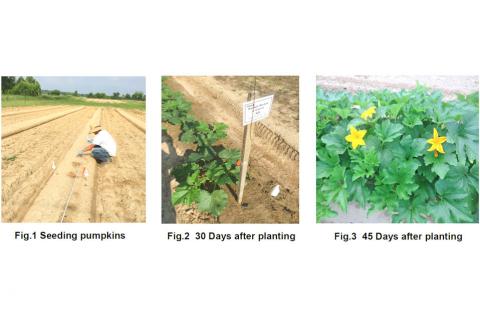
Introduction: In the Southeastern U.S. there are challenges growing pumpkins (Cucurbita pepo), such as hot and humid weather and disease pressures. In North Mississippi a major pest that infects pumpkins is powdery mildew (Sphaerotheca sp.), a fungal disease that causes a decrease in photosynthesis and extensive early defoliation. Growers are advised to choose resistant varieties and spray with fungicides every 7-10 days to achieve acceptable yields. With the increasing interest in growing organically/naturally this study was initiated to trial the organic fungicides Oso (Polyoxin D zinc salt), Double Nickel (Bacillus amyloliquefaciens strain D747), and Cueva (Copper Octanoate) as compared to the standard inorganic fungicides Bravo (chlorothalanil) and Quadris (azoxystrobin). In the current study, 3 pumpkins cultivars ‘Mustang’ powdery mildew resistant, ‘Early Giant’ intermittent powdery mildew resistance, and ‘Gold Medal’ no powdery mildew resistance (Table 1) were grown to compare the bio and conventional fungicides against the control of powdery mildew.
Methods: Experimental design was a randomized complete block with 4 replications. The treatments were applied as a foliar spray at 7 day intervals using a motorized back pack sprayer starting 2 weeks after emergence and continued until harvest. The treatments were 1) Double Nickel (32 oz/acre) and Cueva (64 oz/acre) alternated weekly 2) Oso (6.5 oz/acre) applied weekly 3) Bravo (32 oz/acre) and Quadris (14 oz/acre) alternated weekly and 4) a control (water). All plots were fertilized with conventional fertilizers according to Mississippi State Soil Testing Lab results (80N, 50P, 200K lbs/ac). The pumpkins were direct seeded 7 July at the North Mississippi Research and Extension Center, Verona, MS during the summers of 2015. Plant beds were formed with a press-pan-type bed shaper, 6 in high and 30 inches wide. In-row plant spacing was 2.0 ft and beds were spaced 12.0 ft apart. Every plot consisted of 18 plants, 6 from each cultivar, with each cultivar harvest-ed separately.
Results: Plots were rated for percent disease foliage every 14 days in Aug. and Sept. There were no significant percent disease foliage differences for the fungicide treatments (Table 2). However, Mustang (PMR) had the best disease rating and highest number of pumpkins (Table 3). The first harvest was 7 Oct. when the majority of the pumpkins were orange. Pumpkins were counted, weighed, and measured for height and circumference (Table 1 and 2). There were significant differences in fungicide treatments with pumpkin weight and circumference when comparing the double nickle/cueva and the quadris/bravo to the control (Table 2). Also the biofungicide of double nickle/cueva had the most number of pumpkins per plot, although not significantly different than Oso or quadris/bravo treat-ments (Table 2).
Conclusion: Over all, the double nickle/cueva and the quadris/bravo treatments had significantly higher yields than the Oso and control treatments. Therefore, the current study demonstrate that using biofungicides could be a viable alternative to conventional nom-organic fungicide treatment while still keeping pumpkin yields comparable. In addition, the powdery mildew resistant cultivar Mustang did produce significantly better yields (Table 3). Special thanks to Certis USA for providing the organic fungicides and Abbott & Cobb for the pumpkin seed.
